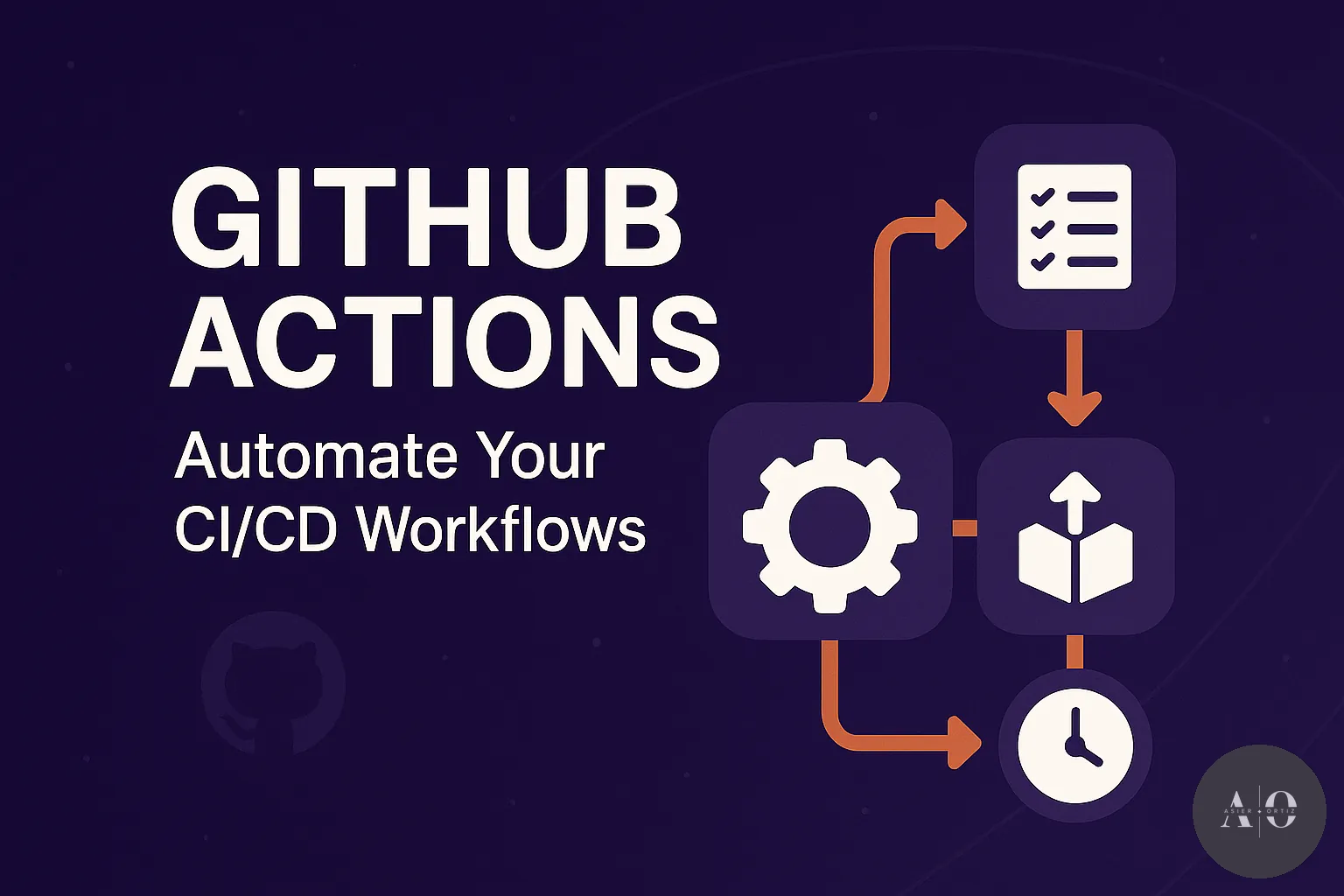Getting Started with GitHub Actions: A Comprehensive Guide for Beginners
Learn how to automate tasks with GitHub Actions. This guide covers the basics, offers tips for beginners, and walks you through setting up your first CI/CD workflows.
GitHub Actions makes it easy to automate your development workflows — from continuous integration to deployment — all directly within your GitHub repository.
Whether you’re shipping a web app, validating a pull request, or generating documentation, Actions help you eliminate repetitive tasks and focus on what matters most: writing code.
This guide is tailored for developers new to CI/CD and GitHub Actions. We’ll break down its core concepts, walk you through creating your first workflow, and explore best practices and real-world use cases.
📋 Table of Contents
What are GitHub Actions?
GitHub Actions is GitHub’s native automation feature that enables CI/CD directly in your repositories. With Actions, you can build and test code, deploy apps, run scheduled tasks, and respond to various GitHub events like pushes, pull requests, issues, and more.
It’s event-driven and tightly integrated with GitHub, making it easy to set up and scale across different projects and languages.
1. Core Concepts
A GitHub Actions workflow is triggered by an event (such as a push, pull_request, or a manual dispatch). That event starts a pipeline of automated steps, which are defined using a structured set of concepts:
- Workflow: A configurable automation file written in YAML, stored in
.github/workflows/. - Job: A group of steps that run on the same virtual environment (also called a runner).
- Step: An individual task — usually a shell command or a call to an action.
- Action: A reusable unit of logic that can be used across workflows. You can use official or community actions from the GitHub Marketplace, or create your own.
- Runner: The virtual machine where jobs are executed (e.g.,
ubuntu-latest,windows-latest).
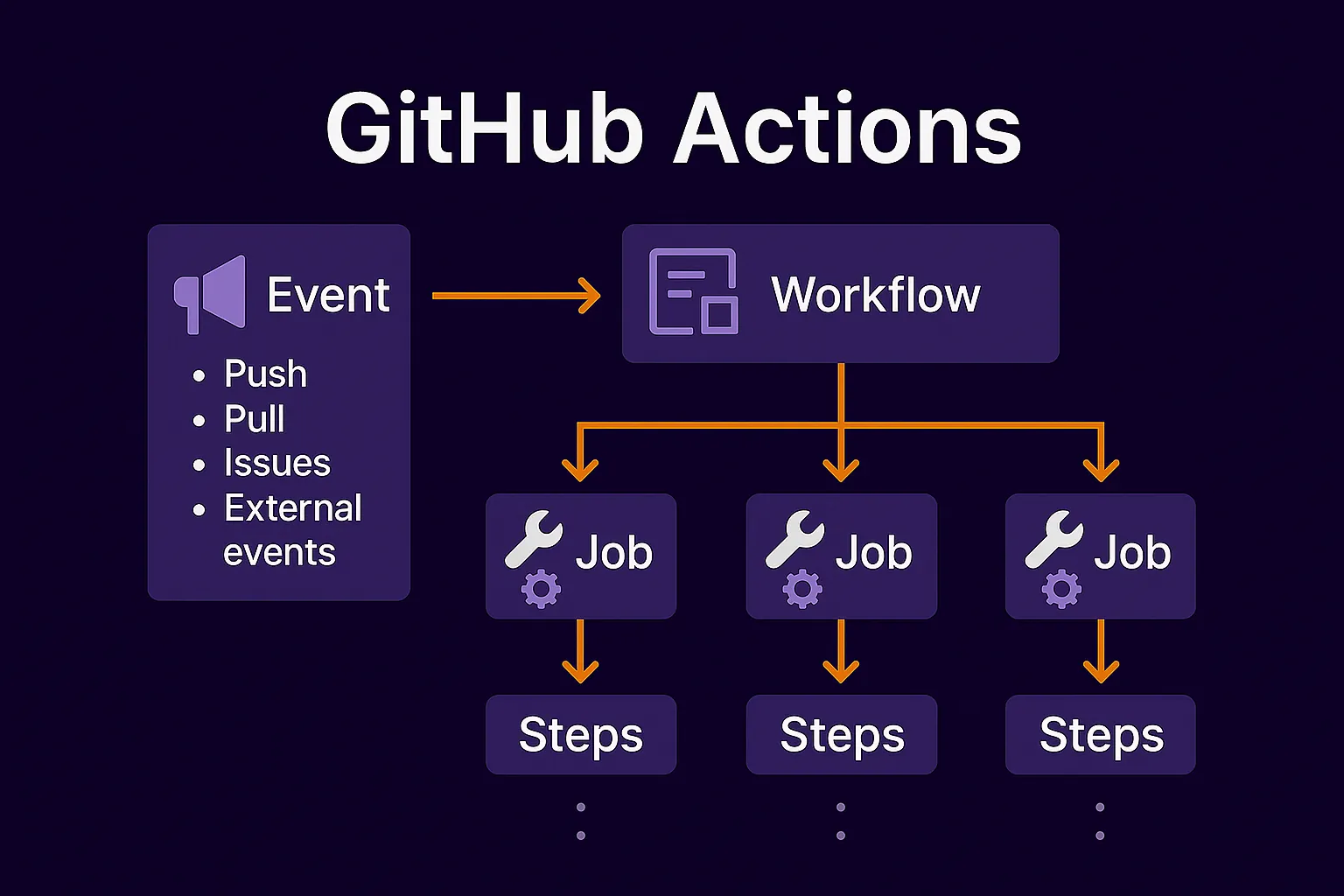
2. Common Use Cases
- CI/CD pipelines: Automate test, build, and deployment cycles.
- Issue management: Label issues, notify teams, or auto-close stale issues.
- Dependency updates: Automatically check for and apply updates.
- Container workflows: Build and publish Docker containers.
- Documentation deployment: Push markdown docs to GitHub Pages.
3. Creating Your First Workflow
If you’re just getting started, the fastest way to create your first GitHub Action is directly from the GitHub interface — no local setup required.
📍 Step-by-Step
Go to your repository on GitHub.
Click the Actions tab in the top menu.
GitHub will suggest templates based on your project.
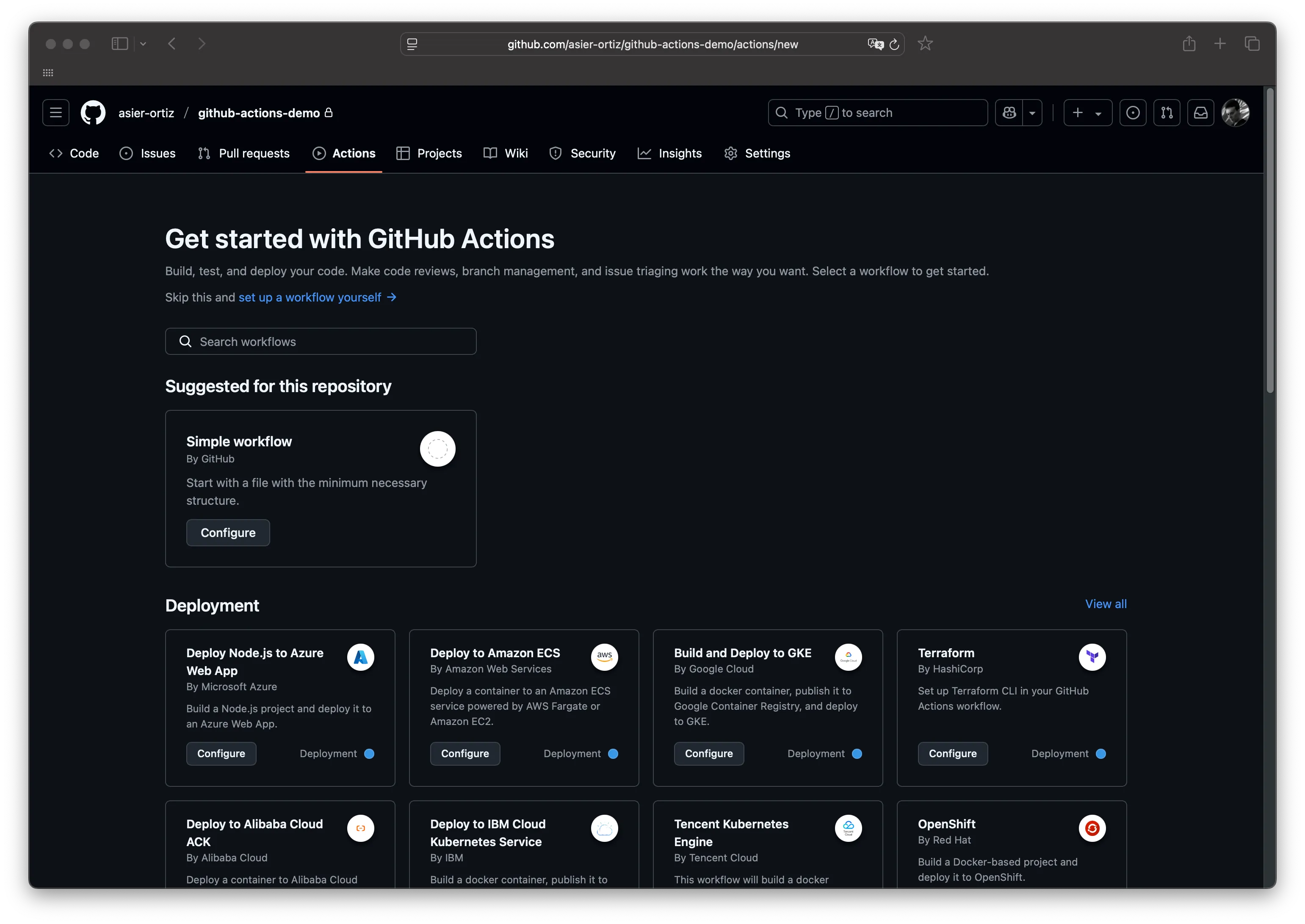
Choose a template or click “set up a workflow yourself” to start from scratch.
GitHub will open a built-in editor with a new file at
.github/workflows/.Paste the following:
name: Hello World on: [push] jobs: greet: runs-on: ubuntu-latest steps: - name: Print greeting run: echo "👋 Hello from your first GitHub Action!"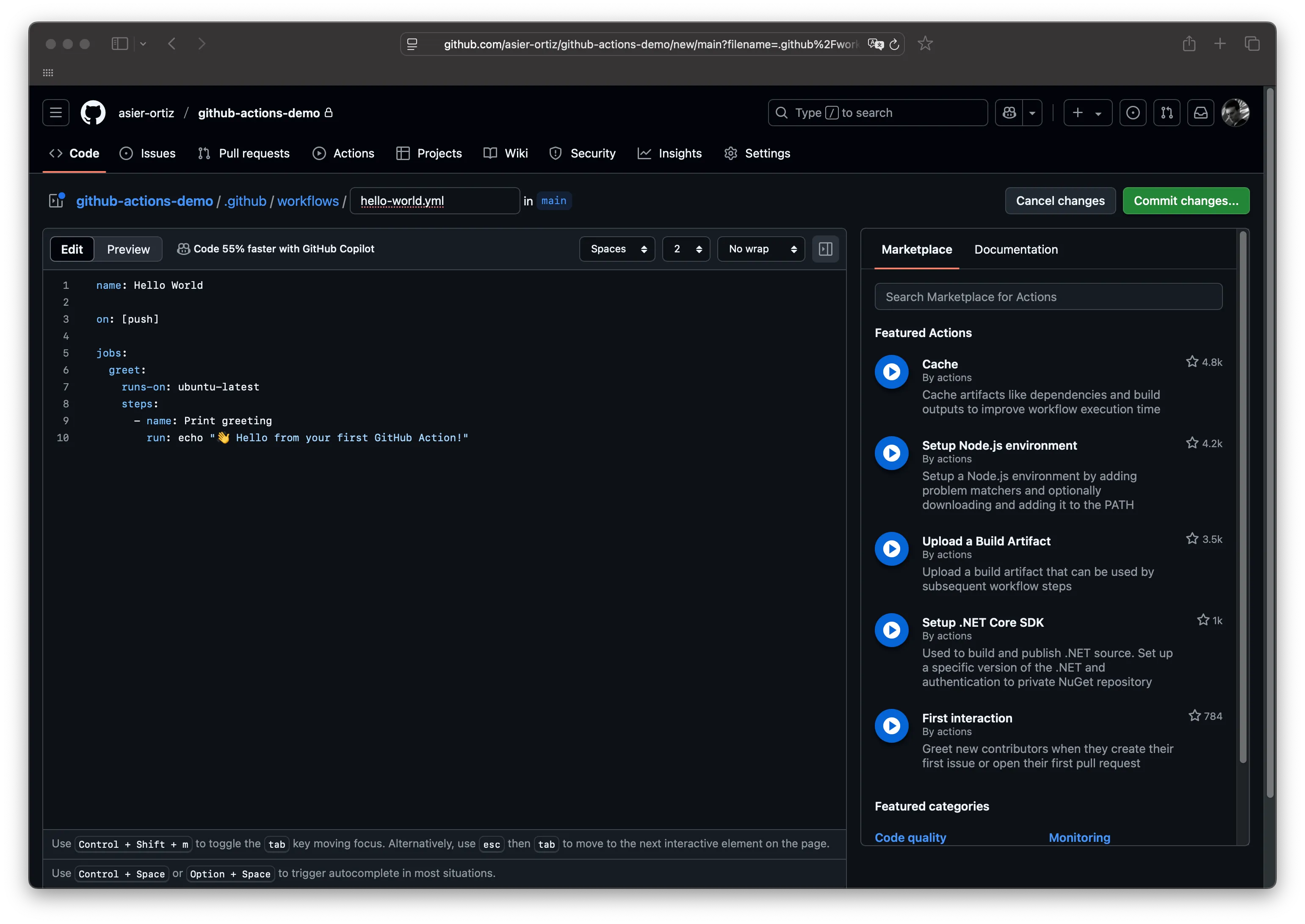
Click Commit changes to save and activate the workflow.
- The workflow will run automatically after each
git push. - You can view its execution in the Actions tab, where each step is logged in real-time.
- If something fails, GitHub shows exactly where and why.
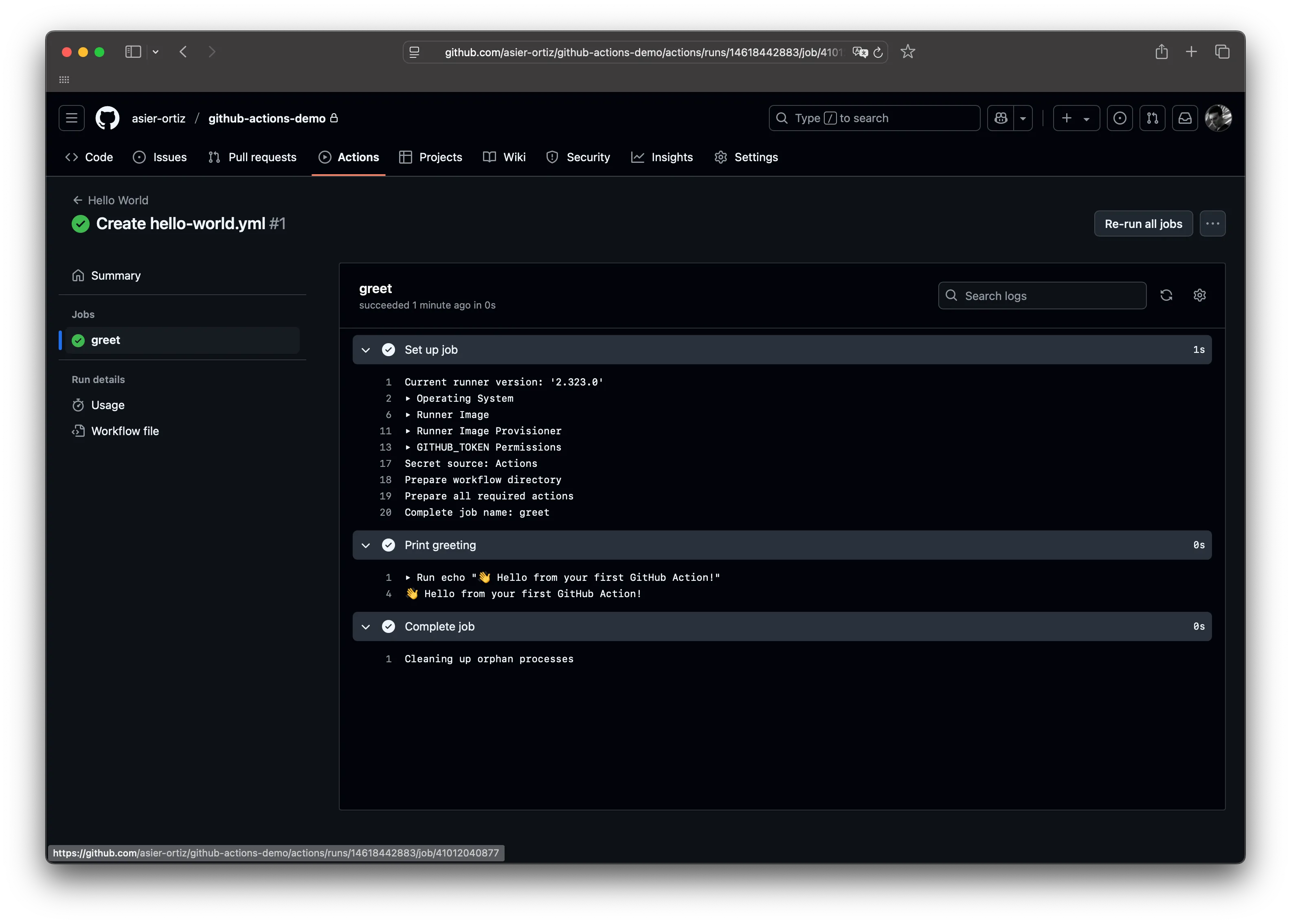
💡 Once you’re comfortable, you can define more complex workflows or store them in your repo directly.
4. Practical Examples
🧪 Example: Continuous Integration for Node.js
name: Node.js CI
on:
push:
pull_request:
jobs:
test:
runs-on: ubuntu-latest
steps:
- name: Checkout code
uses: actions/checkout@v4
- name: Setup Node.js environment
uses: actions/setup-node@v4
with:
node-version: '20'
- name: Install dependencies
run: npm install
- name: Build the project
run: npm run build
- name: Run tests
run: npm testExplanation: Ensures that every change pushed to the repository or suggested through a pull request is automatically validated by building and executing tests.
🧪 Example: Deployment to GitHub Pages
name: Deploy to GitHub Pages
on:
push:
branches:
- main
jobs:
deploy:
runs-on: ubuntu-latest
steps:
- name: Checkout repository
uses: actions/checkout@v4
- name: Build site
run: npm run build
- name: Deploy to GitHub Pages
uses: peaceiris/actions-gh-pages@v3
with:
github_token: ${{ secrets.GITHUB_TOKEN }}
publish_dir: ./distExplanation: After building the project, this workflow publishes the content of the
./distfolder to GitHub Pages automatically.
🧪 Example: Daily Scheduled Cleanup
name: Daily Cleanup
on:
schedule:
- cron: '0 3 * * *' # Runs daily at 3 AM UTC
jobs:
cleanup:
runs-on: ubuntu-latest
steps:
- name: Checkout code
uses: actions/checkout@v4
- name: Cleanup temp files
run: npm run cleanupExplanation: Runs daily to perform maintenance tasks such as cleaning up temporary files.
🧪 Example: Publish to NPM on Tag Push
name: Publish to NPM
on:
push:
tags:
- 'v*.*.*'
jobs:
publish:
runs-on: ubuntu-latest
steps:
- name: Checkout code
uses: actions/checkout@v4
- name: Setup Node.js
uses: actions/setup-node@v4
with:
node-version: '20'
registry-url: 'https://registry.npmjs.org/'
- name: Install dependencies
run: npm install
- name: Publish package
run: npm publish
env:
NODE_AUTH_TOKEN: ${{ secrets.NPM_TOKEN }}Explanation: Triggered when a new version tag is pushed, this workflow installs dependencies and publishes the package to NPM using a secret authentication token.
🧪 Example: Send Slack Notification on Push
name: Slack Notification
on:
push:
jobs:
notify:
runs-on: ubuntu-latest
steps:
- name: Send notification to Slack
uses: rtCamp/action-slack-notify@v2
env:
SLACK_WEBHOOK: ${{ secrets.SLACK_WEBHOOK }}
SLACK_MESSAGE: 'A new commit has been pushed to the repository!'Explanation: Each push triggers a Slack message to a specified channel using a secure webhook URL.
5. Using Secrets in Workflows
You may have noticed that some of the examples above reference values like ${{ secrets.NPM_TOKEN }} or ${{ secrets.SLACK_WEBHOOK }}. These are known as GitHub Secrets, and they’re essential for securely handling sensitive information in your workflows.
Many automation tasks require access to credentials such as API keys, access tokens, or webhook URLs. Instead of hardcoding these into your workflow files (which is insecure and discouraged), GitHub allows you to store them securely in your repository settings.
How to add a secret
- Go to your repository on GitHub.
- Navigate to Settings → Secrets and variables → Actions.
- Click New repository secret.
- Add a name like
NPM_TOKENorSLACK_WEBHOOKand paste the corresponding value.
Once added, you can reference your secret in any workflow file like this:
env:
NODE_AUTH_TOKEN: ${{ secrets.NPM_TOKEN }}6. Advanced Workflows
GitHub Actions can scale with your projects, supporting advanced automation scenarios. Here are some patterns and features you can use to unlock powerful workflows:
- Matrix builds: Run jobs across multiple environments (OS, language versions, etc.) to ensure cross-compatibility.
- Reusable workflows: Share and reuse entire workflows across repositories or teams, improving maintainability.
- Environment-specific jobs: Use conditional logic (
if:) to trigger jobs only in certain environments like staging or production. - Manual triggers: Allow manual execution of workflows through
workflow_dispatch, useful for deployments or fixes. - Artifacts and logs: Upload generated files, logs, or reports using
actions/upload-artifactfor later inspection. - Conditional job chaining: Combine
needsand job outputs to create sophisticated job dependencies. - Dynamic expressions: Use
${{ }}syntax with contexts and functions to dynamically control your workflows (e.g.,${{ github.actor }},${{ steps.step_id.outputs.result }}). - Third-party integrations: Trigger workflows from external services using
repository_dispatchevents.
🧪 Example: Workflow Dispatch with Custom Inputs
on:
workflow_dispatch:
inputs:
environment:
description: 'Deployment target'
required: true
default: 'staging'Enables manual triggering from the GitHub UI with custom parameters.
🧪 Example: Uploading Artifacts
- name: Upload coverage report
uses: actions/upload-artifact@v4
with:
name: coverage-report
path: ./coverage/Save build results, test coverage reports, or other generated assets for download or review.
🧪 Example: Conditional Jobs Based on Environment
jobs:
deploy:
if: github.ref == 'refs/heads/main'
runs-on: ubuntu-latest
steps:
- name: Deploy to production
run: ./deploy.shThis job runs only if the push was to the
mainbranch.
7. Best Practices
- Keep it simple: Break large workflows into smaller, manageable files.
- Cache dependencies: Improve build times using
actions/cache. - Secure secrets: Store tokens and API keys in
Settings > Secrets. - Use pinned versions: Reference specific versions (
@v4,@v2) instead of@latest. - Avoid redundancy: Reuse logic with composite actions or reusable workflows.
- Monitor runs: Set up failure alerts and track metrics.
8. Next Steps
- Read the official GitHub Actions Quickstart.
- Explore pre-built actions on the Marketplace.
- Experiment with advanced features like job dependencies, matrix builds, and composite actions.
- Track workflow runs in the “Actions” tab for insights and debugging.
🌟 Pro tip: Automate documentation updates and changelog generation with GitHub Actions using tools like release-drafter to generate changelogs automatically.
9. Glossary
- Workflow: A YAML-defined automation triggered by GitHub events.
- Runner: A VM or container where a job is executed.
- Job: A set of sequential steps in a workflow.
- Step: A command or action within a job.
- Matrix build: A strategy to run jobs across multiple configurations.
For more terms, visit the GitHub Actions glossary.
🎯 Start with a small automation (like linting or testing), then evolve your workflow as your project grows.
Happy Automating with GitHub Actions! 🚀
